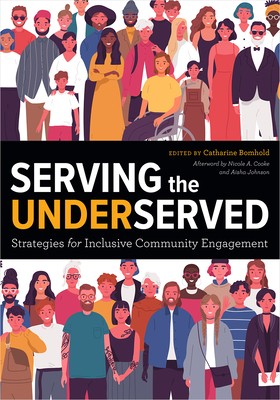
- We will send in 10–14 business days.
- Author: Catharine Bomhold
- Publisher: ALA Neal-Schuman
- ISBN-10: 0838936520
- ISBN-13: 9780838936528
- Format: 17.3 x 24.6 x 1.5 cm, minkšti viršeliai
- Language: English
- SAVE -10% with code: EXTRA
Reviews
Description
Focusing on needs and services outside the library walls, this book outlines a fresh approach to how libraries can think about and effectively reach underserved populations. Readers will discover strategies for identifying information needs where underserved populations are and learn about many successful services, programs, and partnerships.
Underserved populations frequently do not have access to a library--or they may even be unaware that they have an information need. How can we as a profession effectively reach them? This text, geared to both graduate and undergraduate LIS students as well as practicing librarians and library staff, provides contextual information on historically underserved populations as defined by the ALA Office for Diversity, Outreach, and Literacy Services (ODLOS), explores information use behaviors for these groups, and presents examples of successful strategies and programs. Readers will
- understand the history, background, and demographics of ALA-identified underserved population groups, which include refugees and immigrants, rural or isolated communities, historically disadvantaged racial or ethnic groups, LGBTQAI+ teens, people with mental health challenges, and those experiencing homelessness;
- find ideas from real-world practice for effectively serving those population groups in their community;
- learn about concepts such as Reijo Savolainen's everyday life information seeking (ELIS) and Elfreda Chatman's small world lives and life in the round, theories that consider how a person's circumstances affect their information needs, searching habits, and information authorities;
- see why misconceptions, stereotypes, and implicit biases about underserved populations can act as barriers to people accessing the information they need;
- be introduced to the concept of the "community information liaison," a librarian who addresses information-seeking of their community outside of the library walls; and
- have information about support organizations and additional resources for further learning.
The text features contributed chapters from noted authorities such as Paul T. Jaeger, Ana Ndumu, Helen Chou, Bharat Mehra, Jeanie Austin, Emily Jacobson, Julie Hersberger, Carrie Scott Banks, Barbara Klipper, JJ Pionke, Nicole Dalmer, and Vanessa Kitzie, plus an afterword by Nicole A. Cooke.
EXTRA 10 % discount with code: EXTRA
The promotion ends in 21d.07:25:00
The discount code is valid when purchasing from 10 €. Discounts do not stack.
- Author: Catharine Bomhold
- Publisher: ALA Neal-Schuman
- ISBN-10: 0838936520
- ISBN-13: 9780838936528
- Format: 17.3 x 24.6 x 1.5 cm, minkšti viršeliai
- Language: English English
Focusing on needs and services outside the library walls, this book outlines a fresh approach to how libraries can think about and effectively reach underserved populations. Readers will discover strategies for identifying information needs where underserved populations are and learn about many successful services, programs, and partnerships.
Underserved populations frequently do not have access to a library--or they may even be unaware that they have an information need. How can we as a profession effectively reach them? This text, geared to both graduate and undergraduate LIS students as well as practicing librarians and library staff, provides contextual information on historically underserved populations as defined by the ALA Office for Diversity, Outreach, and Literacy Services (ODLOS), explores information use behaviors for these groups, and presents examples of successful strategies and programs. Readers will
- understand the history, background, and demographics of ALA-identified underserved population groups, which include refugees and immigrants, rural or isolated communities, historically disadvantaged racial or ethnic groups, LGBTQAI+ teens, people with mental health challenges, and those experiencing homelessness;
- find ideas from real-world practice for effectively serving those population groups in their community;
- learn about concepts such as Reijo Savolainen's everyday life information seeking (ELIS) and Elfreda Chatman's small world lives and life in the round, theories that consider how a person's circumstances affect their information needs, searching habits, and information authorities;
- see why misconceptions, stereotypes, and implicit biases about underserved populations can act as barriers to people accessing the information they need;
- be introduced to the concept of the "community information liaison," a librarian who addresses information-seeking of their community outside of the library walls; and
- have information about support organizations and additional resources for further learning.
The text features contributed chapters from noted authorities such as Paul T. Jaeger, Ana Ndumu, Helen Chou, Bharat Mehra, Jeanie Austin, Emily Jacobson, Julie Hersberger, Carrie Scott Banks, Barbara Klipper, JJ Pionke, Nicole Dalmer, and Vanessa Kitzie, plus an afterword by Nicole A. Cooke.


Reviews